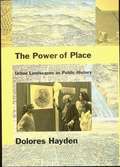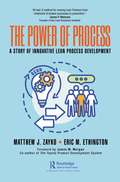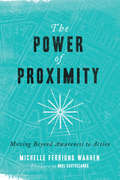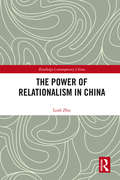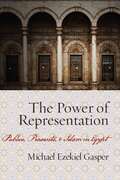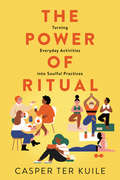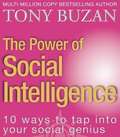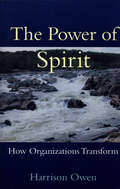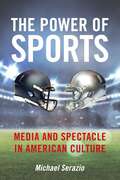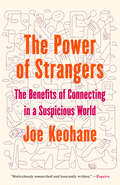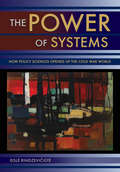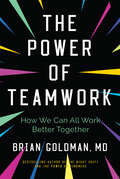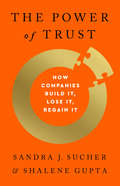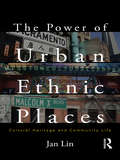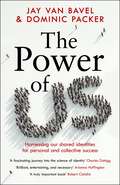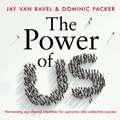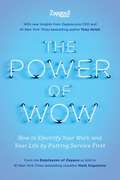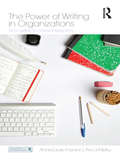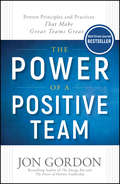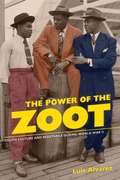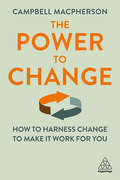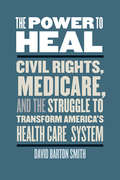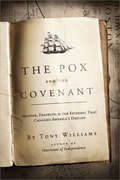- Table View
- List View
The Power of Parasites: Malaria as (un)conscious strategy
by Dalia IskanderThis book describes how malaria both frustrates and facilitates life for Indigenous Pälawan communities living in the forested foothills of the municipality of Bataraza on the island of Palawan in the Philippines. Tracing the arc of malaria on the archipelago from colonial encounters to the present day, it examines the ways in which malaria parasites have become entangled in contemporary lives. It uniquely explores the experiences of local government leaders working towards sustainably developing this last ecological frontier, health workers trying to meet international targets to eliminate malaria, and Pälawan people trying to keep their bodies, social relations and the cosmos in careful balance. In exquisite detail, Dr Dalia Iskander shows how malaria emerged from, and was intrinsic to, a whole host of strategically-orientated social practices that were enacted in as well as around the disease’s name, as people worked day-to-day to gain power in different guises in different arenas.
The Power of Place: Urban Landscapes as Public History
by Dolores HaydenBased on her extensive experience in the urban communities of Los Angeles, historian and architect Dolores Hayden proposes new perspectives on gender, race, and ethnicity to broaden the practice of public history and public art, enlarge urban preservation, and reorient the writing of urban history to spatial struggles. <P><P>In the first part of The Power of Place, Hayden outlines the elements of a social history of urban space to connect people's lives and livelihoods to the urban landscape as it changes over time. She then explores how communities and professionals can tap the power of historic urban landscapes to nurture public memory. <P><P>The second part documents a decade of research and practice by The Power of Place, a nonprofit organization Hayden founded in downtown Los Angeles. Through public meetings, walking tours, artists's books, and permanent public sculpture, as well as architectural preservation, teams of historians, designers, planners, and artists worked together to understand, preserve, and commemorate urban landscape history as African American, Latina, and Asian American families have experienced it. <P><P>One project celebrates the urban homestead of Biddy Mason, an African American ex-slave and midwife active betwen 1856 and 1891. Another reinterprets the Embassy Theater where Rose Pesotta, Luisa Moreno, and Josefina Fierro de Bright organized Latina dressmakers and cannery workers in the 1930s and 1940s. A third chapter tells the story of a historic district where Japanese American family businesses flourished from the 1890s to the 1940s. Each project deals with bitter memories—slavery, repatriation, internment—but shows how citizens survived and persevered to build an urban life for themselves, their families, and their communities. <P><P>Drawing on many similar efforts around the United States, from New York to Charleston, Seattle to Cincinnati, Hayden finds a broad new movement across urban preservation, public history, and public art to accept American diversity at the heart of the vernacular urban landscape. She provides dozens of models for creative urban history projects in cities and towns across the country.
The Power of Process: A Story of Innovative Lean Process Development
by Matthew J. Zayko Eric M. EthingtonLean Process Creation teaches the specific frames—the 6CON model—to look through to properly design any new process while optimizing the value-creating resources. The framing is applicable to create any process that involves people, technology, or equipment—whether the application is in manufacturing, healthcare, services, retail, or other industries. If you have a process, this approach will help. The result is 30% to 50% improvement in first-time quality, customer lead time, capital efficiency, labor productivity, and floorspace that could add up to millions of dollars saved per year. More important, it will increase both employee and customer satisfaction. The book details a case study from a manufacturing standpoint, starting with a tangible example to reinforce the 6CON model. This is the first book written from this viewpoint—connecting a realistic transformation with the detailed technical challenges, as well as the engagement of the stakeholders, each with their own bias. Key points and must-do actions are sprinkled throughout the case study to reinforce learning from the specific to the general. In this study, an empowered working team is charged with developing a new production line for a critical new product. As the story unfolds, they create an improved process that saves $5.6 million (10x payback on upfront resource investment) over the short life cycle of the product, as well as other measurable benefits in quality, ergonomics, and delivery. To an even greater benefit, they establish a new way of working that can be applied to all future process creation activities. Some organizations have tried their version of Lean process design following a formula or cookie-cutter approach. But true Lean process design goes well beyond forcing concepts and slogans into every situation. It is purposeful, scientific, and adaptable because every situation starts with a unique current state. In addition, Lean process design must include both the technical and social aspects, as they are essential to sustaining and improving any system. Observing the recurring problem of reworking processes that were newly launched brought the authors to the conclusion that a practical book focused on introducing the critical frames of Lean process creation was needed. This book enables readers to consider the details within each frame that must be addressed to create a Lean process. No slogans, no absolutes. Real thinking is required. This type of thinking is best learned from an example, so the authors provide this case study to demonstrate the thinking that should be applied to any process. High volume or low, simple or complex mix, manufacturing or service/transactional—the framing and thinking works. Along with the thinking, readers are enabled to derive their own future states. This is demonstrated in the story that surrounds the case study.
The Power of Proximity: Moving Beyond Awareness to Action
by Michelle Ferrigno Warren Noel CastellanosWe can see evidence of injustice all around us, whether in continuing incidents of racial inequality or in the systemic forces that disenfranchise people and perpetuate poverty. It's important to learn about the world's inequities and to be a voice for the voiceless any way we can. But in an age of hashtag and armchair activism, merely raising awareness about injustice is not enough. Michelle Warren knows what is needed. She and her family have chosen to live in communities where they are "proximate to the pain of the poor." This makes all the difference in facing and overcoming injustice. When we build relationships where we live, we discover the complexities of standing with the vulnerable and the commitment needed for long-term change. Proximity changes our perspective, compels our response, and keeps us committed to the journey of pursuing justice for all. Move beyond awareness and experience the power of proximity.
The Power of Relationalism in China (Routledge Contemporary China Series)
by Leah ZhuIn the 21st century, China has become impossible to ignore. At the same time, a vast array of perceptions and judgments of China’s actions and future have arisen. The confusion, Leah Zhu postulates, is explained by decades of traditional modus operandi, which began in the Maoist Era and misconceives China as a ‘collectivist’ culture. This book, however, seeks to re-explore thousands of years of China’s history to demonstrate the country’s adherence to an alternative principle, ‘relationalism’. Tracing the pervasive power of ‘relationalism’ before and after Maoism, it examines the major aspects of Chinese culture, including politics, sociology, psychology and diplomacy. In doing so, it reveals the power of ‘relationalism’ as the core frame of reference behind contemporary Chinese beliefs and practices. Furthermore, armed with this newly established framework, this book ultimately provides a helpful analysis of China’s past political, economic, and judiciary reforms and of how they are faring under the control of the current regime. Featuring extensive evidence and analysis of Chinese culture from ancient rites through to the 21st century, this book will be invaluable to students and scholars of Chinese culture, politics and society. It will also appeal to social scientists and sociologists more broadly.
The Power of Representation
by Michael Ezekiel GasperGasper (history, Yale U. ) traces Egyptian national identity formation from the mid-1870s through the 1910s as a social and political project largely carried out by urban, literate elites. He argues that a good part of this project revolved around changing both the self-conception of the urban intellegentsia and their literary representations of the Egyptian peasantry, placing the peasantry within discourses of reform and nation that valorized their permanence and ceased to draw dividing lines between urban and rural in defining the nation, yet simultaneously placed the urban intelligentsia in the position of being the only legitimate voice of reform on behalf of the peasantry. He places this process within the context of the expansion of commodity production in Egypt and the pivotal impact of Islamic modernism as an ideology of mass mobilization. Annotation ©2009 Book News, Inc. , Portland, OR (booknews. com)
The Power of Ritual: Turning Everyday Activities into Soulful Practices
by Casper ter KuileCasper ter Kuile, a Harvard Divinity School fellow and cohost of the popular Harry Potter and the Sacred Text podcast, explores how we can nourish our souls by transforming common, everyday practices—yoga, reading, walking the dog—into sacred rituals that can heal our crisis of social isolation and struggle to find purpose—a message we need more than ever for our spiritual and emotional well-being in the age of COVID-19.“After half a decade of research and hundreds of conversations with people around the country, I am convinced we are in the midst of a paradigm shift. That what used to hold us in community no longer works, and that the spiritual offerings of yesteryear no longer help us thrive.”–Casper ter KuileWhat do Soul Cycle, gratitude journals, and tech breaks have in common? For ter Kuile they offer rituals that create the foundation for our modern spiritual lives. We are in crisis today. Our modern technological society has left too many of us—no matter our ages—feeling isolated and bereft of purpose. Previous frameworks for building community and finding meaning no longer support us. Yet ter Kuile reveals a hopeful new message: we might not be religious, but that doesn’t mean we are any less spiritual. Instead, we are in the midst of a paradigm shift in which we seek belonging and meaning in secular practices. Today, we find connection in:CrossFit and SoulCycle, which offer a sense of belonging rooted in accountability and support much like church groupsHarry Potter and other beloved books that offer universal lessons Gratitude journals, which have replaced traditional prayer Tech breaks, which provide mindful moments of calm In The Power of Ritual, ter Kuile invites us to deepen these ordinary practices as intentional rituals that nurture connection and wellbeing. With wisdom and endearing wit, ter Kuile’s call for ritual is ultimately a call to heal our loss of connection to ourselves, to others, and to our spiritual identities.The Power of Ritual reminds us that what we already do every day matters—and has the potential to become a powerful experience of reflection, sanctuary, and meaning.
The Power of Social Intelligence
by Tony BuzanPresents ways to develop skills to enable one to feel comfortable in social situations.
The Power of Spirit: How Organizations Transform
by Harrison H. OwenForms and transforms in people, they become strong, focused, and vibrant-and wonderful things can happen. But when the spirit is down, nothing else seems to make a difference-because not too much happens. Many of us today find ourselves trapped in just such organizations. The spirit in our workplace, to say nothing of our own spirit, is getting a little tattered, showing the early stages of what Harrison Owen calls "Soul Pollution." Those in the advanced stages may find themselves plagued by exhaustion, high levels of stress, and the abuse of just about anything in sight, including spouses, substances, and fellow workers. So what is the secret to transforming organizations? The answer, says Owen, is simple: we must consciously be what we already are-natural, open, self-organizing systems. In The Power of Spirit, Owen examines the world of Spirit/Consciousness in organizations and offers help to those who find themselves dreading another day on the job in an organization seemingly bent on its own destruction, as well as the destruction of its members. He draws from what we are now learning about self-organizing systems to provides a practical application to the world of organizations, revealing the ways in which Spirit shows up in new, emergent organizational forms. Widely known for his Open Space Technology-a broadly used meeting management tool-Owen now pushes well beyond that surface appreciation and suggests deeper applications and implications, showing how what has been experienced in a typical "great meeting" with Open Space can actually be a 365-day-a-year reality. For all those interested in Spirit and spirituality, particularly in the workplace, individuals who are feeling down and out and buried by Soul Pollution in the workplace, and for current practitioners of Open Space Technology who are wondering what comes after a "great meeting"-The Power of Spirit will offer a pathway to positive transformation.
The Power of Sports: Media and Spectacle in American Culture (Postmillennial Pop #23)
by Michael SerazioA provocative, must-read investigation that both appreciates the importance of—and punctures the hype around—big-time contemporary American athleticsIn an increasingly secular, fragmented, and distracted culture, nothing brings Americans together quite like sports. On Sundays in September, more families worship at the altar of the NFL than at any church. This appeal, which cuts across all demographic and ideological lines, makes sports perhaps the last unifying mass ritual of our era, with huge numbers of people all focused on the same thing at the same moment. That timeless, live quality—impervious to DVR, evoking ancient religious rites—makes sports very powerful, and very lucrative. And the media spectacle around them is only getting bigger, brighter, and noisier—from hot take journalism formats to the creeping infestation of advertising to social media celebrity schemes.More importantly, sports are sold as an oasis of community to a nation deeply divided: They are escapist, apolitical, the only tie that binds. In fact, precisely because they appear allegedly “above politics,” sports are able to smuggle potent messages about inequality, patriotism, labor, and race to massive audiences. And as the wider culture works through shifting gender roles and masculine power, those anxieties are also found in the experiences of female sports journalists, athletes, and fans, and through the coverage of violence by and against male bodies. Sports, rather than being the one thing everyone can agree on, perfectly encapsulate the roiling tensions of modern American life.Michael Serazio maps and critiques the cultural production of today’s lucrative, ubiquitous sports landscape. Through dozens of in-depth interviews with leaders in sports media and journalism, as well as in the business and marketing of sports, The Power of Sports goes behind the scenes and tells a story of technological disruption, commercial greed, economic disparity, military hawkishness, and ideals of manhood. In the end, despite what our myths of escapism suggest, Serazio holds up a mirror to sports and reveals the lived realities of the nation staring back at us.
The Power of Strangers: The Benefits of Connecting in a Suspicious World
by Joe KeohaneAn entertaining, surprising, and ultimately inspiring look at what happens when we talk to strangers, and why it affects everything from our own health and well-being to the rise and fall of nations in the tradition of Susan Cain&’s Quiet and Yuval Noah Harari&’s Sapiens&“This lively, searching work makes the case that welcoming &‘others&’ isn&’t just the bedrock of civilization, it&’s the surest path to the best of what life has to offer.&”—Ayad Akhtar, Pulitzer Prize–winning author of Homeland ElegiesIn our cities, we stand in silence at the pharmacy and in check-out lines at the grocery store, distracted by our phones, barely acknowledging one another, even as rates of loneliness skyrocket. Online, we retreat into ideological silos reinforced by algorithms designed to serve us only familiar ideas and like-minded users. In our politics, we are increasingly consumed by a fear of people we&’ve never met. But what if strangers—so often blamed for our most pressing political, social, and personal problems—are actually the solution?In The Power of Strangers, Joe Keohane sets out on a journey to discover what happens when we bridge the distance between us and people we don&’t know. He learns that while we&’re wired to sometimes fear, distrust, and even hate strangers, people and societies that have learned to connect with strangers benefit immensely. Digging into a growing body of cutting-edge research on the surprising social and psychological benefits that come from talking to strangers, Keohane finds that even passing interactions can enhance empathy, happiness, and cognitive development, ease loneliness and isolation, and root us in the world, deepening our sense of belonging. And all the while, Keohane gathers practical tips from experts on how to talk to strangers, and tries them out himself in the wild, to awkward, entertaining, and frequently poignant effect.Warm, witty, erudite, and profound, equal parts sweeping history and self-help journey, this deeply researched book will inspire readers to see everything—from major geopolitical shifts to trips to the corner store—in an entirely new light, showing them that talking to strangers isn&’t just a way to live; it&’s a way to survive.
The Power of Systems: How Policy Sciences Opened Up the Cold War World (Cornell Studies In Classical Philology Ser.)
by Egle RindzeviciuteIn The Power of Systems, Egle Rindzeviciute introduces readers to one of the best-kept secrets of the Cold War: the International Institute of Applied Systems Analysis, an international think tank established by the U.S. and Soviet governments to advance scientific collaboration. From 1972 until the late 1980s IIASA in Austria was one of the very few permanent platforms where policy scientists from both sides of the Cold War divide could work together to articulate and solve world problems. This think tank was a rare zone of freedom, communication, and negotiation, where leading Soviet scientists could try out their innovative ideas, benefit from access to Western literature, and develop social networks, thus paving the way for some of the key science and policy breakthroughs of the twentieth century.Ambitious diplomatic, scientific, and organizational strategies were employed to make this arena for cooperation work for global change. Under the umbrella of the systems approach, East-West scientists co-produced computer simulations of the long-term world future and the anthropogenic impact on the environment, using global modeling to explore the possible effects of climate change and nuclear winter. Their concern with global issues also became a vehicle for transformation inside the Soviet Union. The book shows how computer modeling, cybernetics, and the systems approach challenged Soviet governance by undermining the linear notions of control on which Soviet governance was based and creating new objects and techniques of government.
The Power of Teamwork: How We Can All Work Better Together
by Dr. Brian GoldmanNew from the bestselling author of The Power Kindness and host of CBC Radio’s White Coat, Black ArtIn the high-pressure and complex setting of healthcare, a new approach to teamwork is leading to healthier patients, happier staff and more efficient operations. Healthcare’s embrace of a new teamwork model has been noticed by people outside the medical world, so doctors are going outside the walls of the hospital to teach manufacturers, business owners, franchisees, customer service representatives and even those in sports and entertainment to do better by shifting the culture from “me” to “we.” Drawing on groundbreaking research and examples from around the world, The Power of Teamwork shows how a team approach to medicine can improve customer service and help women break the glass ceiling. It can solidify the provision of social services to troubled youth, and boost the efficiency and safety of the military and critical industrial complexes like nuclear power plants. It can even make professional sports teams perform better.
The Power of Trust: How Companies Build It, Lose It, Regain It
by Sandra J. Sucher Shalene GuptaA ground-breaking exploration of the changing nature of trust and how to bridge the gap from where you are to where you need to be. Trust, at every level of business and society, has never mattered so much and at the same time. CEOs, managers, presidents, governors - leaders at every level and in every institution - face vexing issues and trade-offs. Many flounder, especially in a turbulent era when confronted with multiple crises and constituencies demanding change. How to bridge these gaps requires a new understanding of just what trust is, how it can be built, and regained when lost.Trust is, however, an elusive, even mushy, concept. Sandra Sucher and Shalene Gupta examine the science behind trust, grounding our understanding of why we humans trust in the first place, describing how customers, employees, community members and investors decide whether an organization or a person can be trusted. Creating and sustaining trust does not, they show, come from "reputation-building" and PR but by being the "real deal," creating products, services, and technologies that work, having good intentions, treating people fairly, and taking responsibility for all the impacts an organization creates, whether intended or not.Then, through a framing of how to think through the elements of trust - competence, motives, means, impact - combined with in-depth stories from twenty years of research we emerge with a new understanding of the business, economic and societal importance of trust and how to regain it once lost. How to, in short, bridge the gap from where you are to where you should be.
The Power of Urban Ethnic Places: Cultural Heritage and Community Life
by Jan LinThe Power of Ethnic Places discusses the growing visibility of ethnic heritage places in U.S. society. The book examines a spectrum of case studies of Chinese, Latino and African American communities in the U.S., disagreeing with any perceptions that the rise of ethnic enclaves and heritage places are harbingers of separatism or balkanization. Instead, the text argues that by better understanding the power and dynamics of ethnic enclaves and heritage places in our society, we as a society will be better prepared to harness the economic and cultural changes related to globalization rather than be hurt or divided by these same forces of economic and cultural restructuring.
The Power of Us: Harnessing Our Shared Identities for Personal and Collective Success
by Jay Van Bavel Dominic J. PackerIf you're like most people, you probably believe that your identity is stable. But in fact, your identity is constantly changing - often outside your conscious awareness and sometimes even against your wishes - to reflect the interests of the groups of which you're a part. And that fluid identity has a powerful influence over your feelings, beliefs, and behaviours.In THE POWER OF US, psychologists Packer and Van Bavel integrate their own cutting-edge research in psychology, neuroscience and economics to explain what identity really is and show how to harness its dynamic nature to:Increase our productivity - Improve physical and psychological health - Overcome our individual prejudice - Unlock our altruism - Break the political gridlock - Galvanize others to solve controversial global problemsAlong the way, they explain such seemingly unrelated phenomenon as why men cry at football games but not funerals, why the history of slavery in U.S. counties is one of the best predictors of current day racism, and why Canada keeps a national reserve of maple syrup. Packed with fascinating insights, vivid case studies, and pioneering research, THE POWER OF US will change the way you understand yourself - and those around you - forever.
The Power of Us: Harnessing Our Shared Identities for Personal and Collective Success
by Jay Van Bavel Dominic J. PackerIf you're like most people, you probably believe that your identity is stable. But in fact, your identity is constantly changing - often outside your conscious awareness and sometimes even against your wishes - to reflect the interests of the groups of which you're a part. And that fluid identity has a powerful influence over your feelings, beliefs, and behaviours.In THE POWER OF US, psychologists Dominic Packer and Jay Van Bavel integrate their own cutting-edge research in psychology, neuroscience and economics to explain what identity really is and show how to harness its dynamic nature to:- Increase our productivity- Improve physical and psychological health- Overcome our individual prejudice- Unlock our altruism- Break the political gridlock- Galvanize others to solve controversial but persistent global problems.Along the way, they explain such seemingly unrelated phenomenon as why men cry at football games but not funerals, why the history of slavery in U.S. counties is one of the best predictors of current day racism, and why Canada keeps a national reserve of maple syrup. Packed with fascinating insights, vivid case studies, and a wealth of pioneering research, THE POWER OF US will change the way you understand yourself - and the people around you - forever.(P)2021 Hachette Audio
The Power of WOW: How to Electrify Your Work and Your Life by Putting Service First
by Tony Hsieh Mark Dagostino The Employees of Zappos.ComHappy customers. Passionate employees. A highly recognizable brand known for delivering on its promises. That's the power of WOW. From its birth during the Dot Com Boom in 1999 to its acquisition by Amazon in 2009, Zappos, the customer service company that just happens to sell things online, continues to turn heads with its disruptively entrepreneurial spirit and radically innovative employees. Ever unfolding throughout two decades, Zappos continues to outlive the seemingly inevitable short lifespan of the average corporate company. How do they do it? In The Power of WOW, the essential follow-up to Tony Hsieh's Delivering Happiness, Zapponians from every part of the business share powerful stories and lessons that they have learned in business and life––from delivering empathetic customer service in the face of devastating circumstances to creating a self-organized organizational structure using Market-Based Dynamics and everything in between. Fast-paced and filled with authentic, diverse voices, The Power of WOW gives readers an exclusive and immersive understanding of how one company is finding resilience. This glimpse inside the world of Zappos shows how a self-organized company is opening up avenues for passionate individuals to unleash their undiscovered strengths in the workplace and evolve the business from the inside out. Whether you are a customer, an employee, a business leader, shareholder, entrepreneur, or just happened to pick up this book, The Power of WOW will, ultimately, show how leading and infusing humanity into the workplace can change everything in your business, your community, and your life.
The Power of Writing in Organizations: From Letters to Online Interactions (Organization and Management Series)
by Anne-Laure Fayard Anca MetiuThis book demonstrates the power of writing in informal and formal organizations in the past and the present. It shows how writing, despite long lasting criticisms that can be traced back to Plato, and in spite of its frequent definition as a mere recording medium is in fact a creative mode of communication that supports the expression of emotions, the developing knowledge, and the building of strong communities among faraway individuals. The first part of the book illustrates how this has been true historically. The focus on writing as a fundamental mode of communication – the other being speech or the oral mode – is still important in our technology-infused world, where writing seems to have been reduced to short cryptic text messages or tweets. Precisely because of their heavy reliance on technology, current practices are in need of a deeper understanding that focus on deep as opposed to surface features and unveil the four essential mechanisms – objectification, reflecting, specifying, and addressing – that give writing its creative powers. In the second part of the book, we use contemporary case studies and interviews to illustrate how shifting our focus from the media to the mode of communication and focusing on the mechanisms of writing allows us to go beyond current debates about the capabilities of various communication media and to understand better today’s communicative practices. This book is an attempt to unveil the powers of writing as well as to highlight the implications for organizations of the potential loss of these powers in today’s world where writing-based distributed collaborations, interpersonal relationships, and online communities are key sources of innovation and support for individuals and organizations.
The Power of a Positive Team: Proven Principles and Practices that Make Great Teams Great (Jon Gordon)
by Jon GordonA book about teams to help teams become more positive, united and connected. Worldwide bestseller — the author of The Energy Bus and The Power of Positive Leadership shares the proven principles and practices that build great teams - and provides practical tools to help teams overcome negativity and enhance their culture, communication, connection, commitment and performance. Jon Gordon doesn’t just research the keys to great teams, he has personally worked with some of the most successful teams on the planet and has a keen understanding of how and why they became great. In The Power of a Positive Team, Jon draws upon his unique team building experience as well as conversations with some of the greatest teams in history in order to provide an essential framework, filled with proven practices, to empower teams to work together more effectively and achieve superior results. Utilizing examples from the writing team who created the hit show Billions, the National Champion Clemson Football team, the World Series contending Los Angeles Dodgers, The Miami Heat and the greatest beach volleyball team of all time to Navy SEAL’s, Marching bands, Southwest Airlines, USC and UVA Tennis, Twitter, Apple and Ford, Jon shares innovative strategies to transform a group of individuals into a united, positive and powerful team. Jon not only infuses this book with the latest research, compelling stories, and strategies to maintain optimism through adversity… he also shares his best practices to transform negativity, build trust (through his favorite team building exercises) and practical ways to have difficult conversations—all designed to make a team more positive, cohesive, stronger and better. The Power of a Positive Team also provides a blueprint for addressing common pitfalls that cause teams to fail—including complaining, selfishness, inconsistency, complacency, unaccountability—while offering solutions to enhance a team’s creativity, grit, innovation and growth. This is a book meant for teams to read together. It’s written in such a way that if you and your team read it together, you will understand the obstacles you will face and what you must do to become a great team. If you read it together, stay positive together, and take action together you will accomplish amazing things TOGETHER.
The Power of the Zoot: Youth Culture and Resistance During World War II
by Luis AlvarezProviding a new history of youth culture based on rare, in-depth interviews with former zoot-suiters, Luis Alvarez explores race, region, and the politics of culture in urban America during World War II. He argues that Mexican American and African American youths, along with many nisei and white youths, used popular culture to oppose accepted modes of youthful behavior, the dominance of white middle-class norms, and expectations from within their own communities.
The Power to Change: How to Harness Change to Make it Work for You
by Campbell MacphersonHow we work, the way we live, even how long we live are changing at such a breathtaking pace that only those who can embrace everything that's going on and reinvent themselves will survive and thrive.Yet change - even good change - is tough. Most of us feel utterly powerless when confronted by it, but we're not. Learn to harness challenging situations and see the new opportunities with The Power to Change.The Power to Change does more than simply enable you just to cope with change - it gives you the tools and approaches to embrace and celebrate change. Written by award-winning author, Campbell Macpherson, this book provides a genuinely unique approach to celebrating change that will resonate with readers, no matter what sort of change they have to confront. The Power to Change gives readers the permission to feel emotional and have doubts and fears about change. It provides a range of techniques to put change into perspective, and allows readers to embrace and prosper from the challenges it presents.
The Power to Heal: Civil Rights, Medicare, and the Struggle to Transform America's Health Care System
by David Barton SmithIn less than four months, beginning with a staff of five, an obscure office buried deep within the federal bureaucracy transformed the nation's hospitals from our most racially and economically segregated institutions into our most integrated. These powerful private institutions, which had for a half century selectively served people on the basis of race and wealth, began equally caring for all on the basis of need.The book draws the reader into the struggles of the unsung heroes of the transformation, black medical leaders whose stubborn courage helped shape the larger civil rights movement. They demanded an end to federal subsidization of discrimination in the form of Medicare payments to hospitals that embraced the "separate but equal" creed that shaped American life during the Jim Crow era. Faced with this pressure, the Kennedy and Johnson Administrations tried to play a cautious chess game, but that game led to perhaps the biggest gamble in the history of domestic policy. Leaders secretly recruited volunteer federal employees to serve as inspectors, and an invisible army of hospital workers and civil rights activists to work as agents, making it impossible for hospitals to get Medicare dollars with mere paper compliance. These triumphs did not come without casualties, yet the story offers lessons and hope for realizing this transformational dream.
The Power to Heal: Civil Rights, Medicare, and the Struggle to Transform America's Health Care System
by David Barton SmithIn less than four months, beginning with a staff of five, an obscure office buried deep within the federal bureaucracy transformed the nation's hospitals from our most racially and economically segregated institutions into our most integrated. These powerful private institutions, which had for a half century selectively served people on the basis of race and wealth, began equally caring for all on the basis of need. The book draws the reader into the struggles of the unsung heroes of the transformation, black medical leaders whose stubborn courage helped shape the larger civil rights movement. They demanded an end to federal subsidization of discrimination in the form of Medicare payments to hospitals that embraced the "separate but equal" creed that shaped American life during the Jim Crow era. Faced with this pressure, the Kennedy and Johnson Administrations tried to play a cautious chess game, but that game led to perhaps the biggest gamble in the history of domestic policy. Leaders secretly recruited volunteer federal employees to serve as inspectors, and an invisible army of hospital workers and civil rights activists to work as agents, making it impossible for hospitals to get Medicare dollars with mere paper compliance. These triumphs did not come without casualties, yet the story offers lessons and hope for realizing this transformational dream.This book is the recipient of the Norman L. and Roselea J. Goldberg Prize from Vanderbilt University Press for the best book in the area of medicine.
The Pox and the Covenant
by Tony WilliamsFor one hundred years, God had held to his promise, and the colonists had as well. When the first Puritans sailed into Massachusetts in the seventeenth century, weak from the ocean journey, they formed a covenant with each other and with God to establish a city on a hill-a commitment to live uncorrupted lives together or all suffer divine wrath for their collective sin. But now, a century later, the arrival of one doomed ship would put this covenant to its greatest test. On April 22, 1721, the HMS Seahorse arrived in Boston from the West Indies, carrying goods, cargo, and, unbeknownst to its crew, a deadly virus. Soon, a smallpox epidemic had broken out in Boston, causing hundreds of deaths and panic across the city. The clergy, including the famed Cotton Mather, turned to their standard form of defense against disease: fasting and prayer. But a new theory was also being offered to the public by the scientific world: inoculation. The fierce debate over the right way to combat the tragedy would become a battle between faith and reason, one that would set the city aflame with rage and riot. The Pox and the Covenant is a story of well known figures such as Cotton Mather, James Franklin, and a young Benjamin Franklin struggling to fight for their cause among death and debate-although not always for the side one would expect. In the end, the incredible results of the epidemic and battle would reshape the colonists' view of their destiny, setting for America a new course, a new covenant, and the first drumbeats of revolution.

